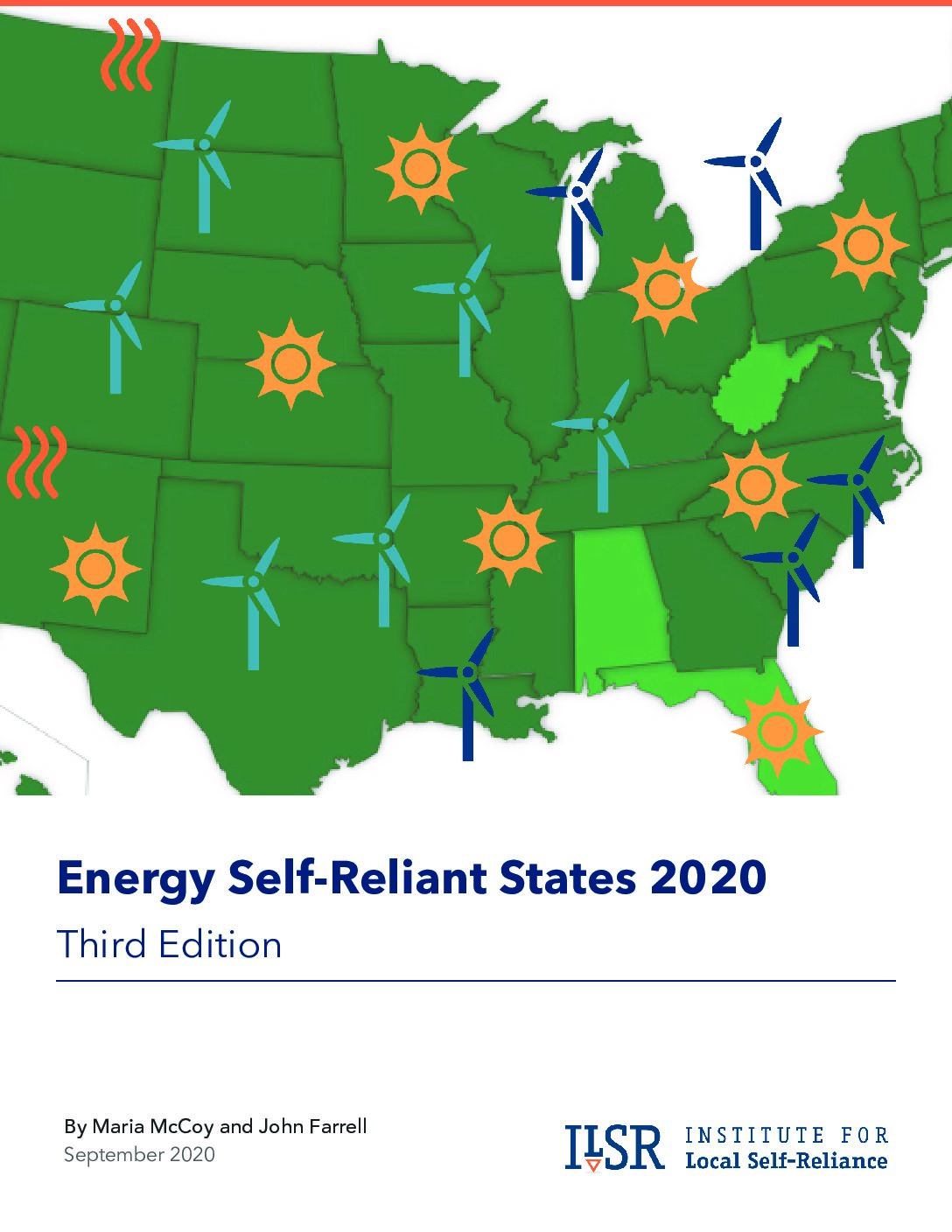
Introduction
If each U.S. state took full advantage of its renewable resources, how much electricity would it produce? How much of its own electricity consumption could renewable energy fulfill? Would in-state renewable generation be enough to charge electric vehicles and power electric heating, too? In 2010, ILSR published the first national overview of state renewable electricity potential with the second edition of Energy Self-Reliant States (ESRS). At the time, most states were setting ambitious goals to attain 25 percent renewable electricity.
Now, several states and over 100 U.S. cities have made truly ambitious commitments to 100 percent renewable power. Fortunately, this third edition finds a better technical outlook and a brighter economic picture than a decade ago. States have much better renewable energy resources than they thought. Also, the costs of renewable electricity sources, like wind and solar, have declined precipitously. The 20-year average cost (often called the “levelized cost”) of solar electricity has declined from around $0.200 per kilowatt-hour for small scale projects to $0.091 per kilowatt-hour. The decline is even more dramatic for utility-scale solar, with the levelized cost falling from $0.120 to about $0.037 per kilowatt-hour. Wind energy costs have declined by significant margins, as well, from around $0.13 to $0.04 per kilowatt-hour.
Clean energy is not only affordable, it is a big contributor to the U.S. economy. At the start of 2020, the clean energy industry employed 3.3 million people – that’s 40 percent of America’s energy workforce. The clean energy sector is strong and growing stronger; the U.S. Bureau of Labor Statistics predicts that solar installers and wind technicians will be the fastest growing occupations in the next decade.
A nation of renewable-powered, job-generating, self-reliant states is within reach – and necessary. The fossil fuel industry harms human health, especially the historically marginalized communities who are disproportionately likely to live near a toxin-emitting power plant. Fossil fuel combustion releases nitrogen oxides, sulfur dioxide, and particulate matter, which all contribute to heart attacks, asthma, and respiratory diseases. Before the fuels are even combusted, oil and gas leaks contaminate air, water, and soil at an alarming rate. Gas combustion and leaks in the home also contribute to asthma. By displacing fossil fuel-fired plants and infrastructure with renewable power, communities reduce these dangers for all.
Renewable energy also makes cities more resilient. Extreme weather events, driven by climate change, have catastrophic impacts on fossil fuel infrastructure and centralized power grids. Renewable energy technologies are more conducive to a distributed system, including rooftop solar paired with batteries, that can help communities bounce back faster. Several cities – including Burlington, Vt. and Georgetown, Tex. – already source 100 percent of their electricity from renewable resources. Local and state policy tools like rooftop solar mandates and community choice energy, covered in separate publications from the Institute for Local Self-Reliance, can help communities tap the potential illustrated in this report. These innovative cities already know what this report tells decision makers in every state; not only can most states meet all of their current and future electricity needs with in-state, renewable resources, most could do it several times over.3
The following maps illustrate nationwide renewable electricity potential from a wide variety of sources.
Some exciting energy sources considered in the second edition never saw significant commercial development. Accordingly, we dropped enhanced geothermal and combined heat and power from the analysis. Although they are slow-growing, small hydro and conventional geothermal remain in this edition. Offshore wind is on the cusp of major development and we’ve updated its estimated potential and the related map. Rooftop solar also remains. Utility-scale solar is not mapped – every state has sufficient undeveloped land area to produce 100 percent of its annual electricity use from solar alone. Another useful resource, energy storage, wasn’t considered at all – but it could fundamentally change the conventional wisdom that massive investments in transmission, or even gas backup power, would be required to tap the full potential in each state.
As before, we’ve considered energy efficiency, creating a version of our all-resources potential map that considers the difference if all states could match their energy intensity to a state like New York (a decrease in energy use per dollar of GDP for most states). A new layer considers how renewables could meet the increased energy demand required for the electrification of vehicles and buildings. Finally, we present an all-resources potential map that imagines a state of both lower energy intensity and high electrification, where the state taps its renewable electricity potential to power more of the total economy.
The bottom line is that improved renewable electricity technology would allow nearly every state to produce 100 percent of its electricity needs from local renewable resources.
Neither energy efficiency nor the ambitious electrification scenario significantly impact the potential of state electricity self-reliance. Without further ado, the maps await…
